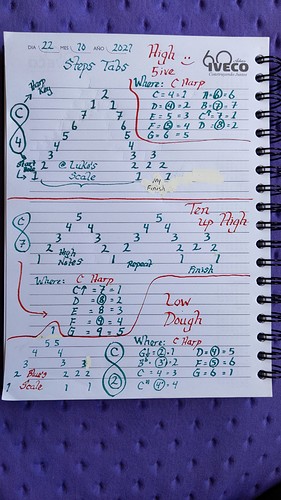Don’t tell anyone, but YES, I do sometimes take my harp into the shower with me, particularly when a wanna give it a quick rinse and dry… 
The acoustics really are great in the bathroom in general, regardless of what we are doing: shaving, showering or… SHINING like a rock star while playing the harmonica and dancing naked in front of the mirror…  Not that I’ve actually ever done that, I’m just saying…
Not that I’ve actually ever done that, I’m just saying… 
If I could just find a way to play while I am eating and sleeping, it would be great!
I LOVE your steps idea and it makes a lot of sense. I’ve started doing scales again as you and @AstridHandbikebee63 have both suggested. As I do so, the steps make it easier for me to understand the changes in pitch from one note to the next. Too bad there isn’t some kind of a tab format showing the steps progression, though maybe there is one? 

I believe I finally figured out what my problem is with number tabs for songs. My mind confuses the “-” sign before draws with going up or down in pitch, which works out on the upper part of the harp but not on the lower.
I wrote out the tabs for a song I’ve been learning now and replaced all the “minus” signs with a circle around draw numbers. My mind seems to grasp this a bit better.
The steps seem to be a more natural way of visualizing the changes in pitch up and down the scale. Now comes the practice of isolating them.
In particular, I’m also enjoying an exercise I do going up and down the entire harp from 1 blow all the way up to 10 blow. The scales aren’t perfect and you get a double G down with the “Low Dough” (I was listening to Jason Mraz song The Dynamo of Volition this morning - I love that song  ) on the 2 draw and 3 blow but it gives me a chance to try and get a nice clean note with blows and draws on every hole and also practice the six to seven change over in the middle.
) on the 2 draw and 3 blow but it gives me a chance to try and get a nice clean note with blows and draws on every hole and also practice the six to seven change over in the middle.
I sometimes practice this at very low volumes as I walk and am puffing up a hill and don’t have much breath. I really like the sound of a nice, slow, easy blow and draw; rather than a fast, loud, aggressive one. Kind of like many other things of life I can think of, though I suppose there’s a time for each. 
@Luke, are there any advantages to playing at higher and/or lower volumes when practicing? Other than perhaps annoying your family and neighbors? 

 I have a decent Lee Oscar harp. Do these harps change with time? Should I have been cleaning every so often (never dipped in water). My DannyBoy sounds great until I have to hit the ‘A’ note. Unfortunately, there are 2 'A’s in this song. I am afraid to play this for my 4 year old granddaughter
I have a decent Lee Oscar harp. Do these harps change with time? Should I have been cleaning every so often (never dipped in water). My DannyBoy sounds great until I have to hit the ‘A’ note. Unfortunately, there are 2 'A’s in this song. I am afraid to play this for my 4 year old granddaughter 
 – I hope that in the next several days I can accomplish this and hopefully help those unsure about how to do it.
– I hope that in the next several days I can accomplish this and hopefully help those unsure about how to do it.




